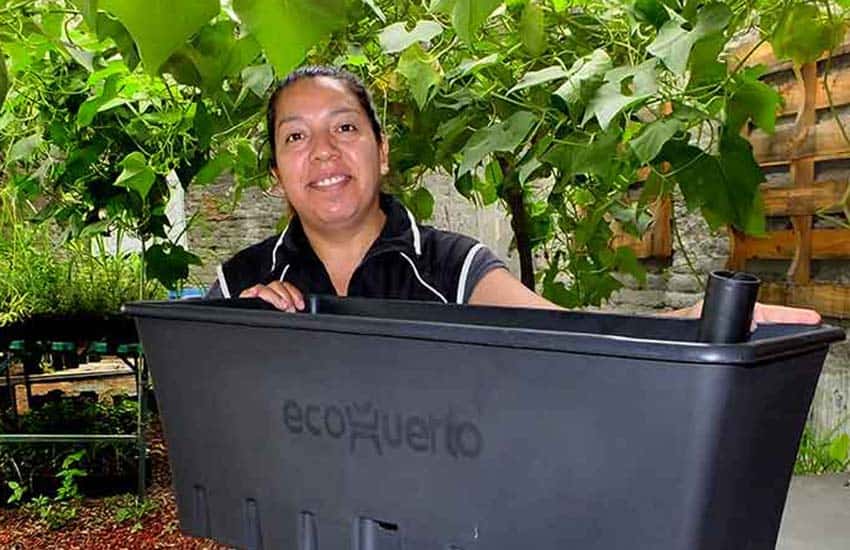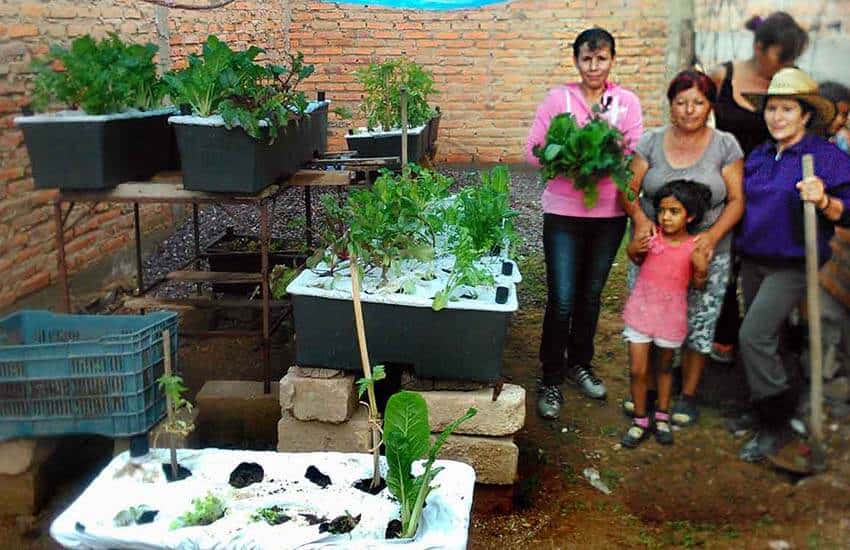Robert Patterson worked for the United Nations Food and Agriculture Organization (FAO) for over 30 years and eventually became the FAO’s senior liaison officer in North America, managing programs all over the world and searching for projects to make good, healthy food accessible to the world’s ever-increasing population. In 2002, he worked on ways to make it easy for women and children to grow vegetables at home, and launched a program called The Growing Connection.
“Perhaps the best solution we found was the earthbox,” he told me in his garden-enclosed “office” in Guadalajara. “The inventor of this system was Blake Whisenant, a tomato farmer in Florida. He faced the problem of hurricanes, which could easily destroy tomato gardens.
One day, Whisenant was distracted in church and came up with the idea of a containerized system that works exactly the same as a traditional garden in the ground but protects the inputs and saves a lot of water — as much as 80% — as well as fertilizer.
Patterson showed me the anatomy of an earthbox, and I must say, it is wonderfully clever. Each box has a filling tube in a corner into which you pour water. The box has a double bottom, and the water goes down to the lower level, which has a capacity of 10 liters.
The upper section holds the “soil,” which is a mixture of coconut fiber from Colima, perlite and worm castings. You apply an ecofriendly fertilizer, consisting of organic compost and organic fish flour.

Along with all that, you also receive a few California red worms. “More fertile than this you can’t get!” Patterson said with a smile.
A plastic film used to be stretched over the top of the box with up to eight holes for the plants to poke through. Today, the film has been replaced by wood chip mulch, which performs the same function. The dynamics of what happens inside the earthbox are most interesting.
At the two bottom corners, the soil is in contact with the water chamber. Capillary action brings the water all the way to the top, where it condenses on the mulch or plastic cover and drips down onto the soil.
“The water is constantly in motion,” Patterson said, “bringing fresh nutrients to the roots. It’s as if you were relaxing in a hammock and somebody was bringing you a beer and a sandwich every two hours.”
What happens inside an earthbox reminds me of the very successful chinampa farming system used before the Spaniards’ arrival in Mexico. Small squares of land were watered by irrigation ditches that crisscrossed the fields. Water reached the plants from below by capillary action, constantly bringing them new nutrients.
In a sense, you could say Bob Patterson is presenting Mexico with a “chinampa in a box.”

I asked Patterson how he got from the FAO to this project in Guadalajara.
“It all started with a series of concerts called Groundwork, which I organized in 2001 in Seattle, Washington, to combat world hunger,” he said.
One of the bands that played at the concert along with REM, Pearl Jam and Alanis Morissette was Guadalajara’s own Maná. “We liked each other,” he said, “and they liked my work.”
Maná — which supports several very successful conservation projects in Latin America — asked Patterson to bring earthboxes to Mexico. They helped finance the project by donating US $1 for every ticket they sold on their tour of the United States.
Patterson was happy to exchange his FAO job, which mainly involved office work, for a project that would bring him into direct contact with people who need help.
He teamed up with Margarita Álvarez, a longtime friend of Maná, and together they started Earthbox Mexico with headquarters in Guadalajara under the brand name EcoHuerto, which means something like “Eco Garden” and is a whole lot easier for Spanish speakers to pronounce than the word “earthbox.”

They started out by working in Jalisco’s Sierra Huichol, which has an altitude of 3,000 meters. There, they found, “there’s no water and no green, and all the local people have infected eyes and skin — habitually.”
Not surprisingly, once these people began eating leafy greens grown in earthboxes, the infections disappeared.
“We’ve also worked with indigenous communities in Chiapas, Zacatecas, Nayarit and Chihuahua,” Álvarez told me. “These people live in the most remote places imaginable, and they have unproductive land in most cases. So there they are with terrible land and terrible nutrition, living at the far end of terrible roads.”
“Sometimes our truck would make it all the way, but sometimes we would have to walk several hours more, and, of course, we would have to carry the equipment on our backs,” she added. “Then we would set up earthboxes at the local community center, school or even a private home.”
When they started, all their earthboxes were made in the United States.
“But a few years later, we bought a mold from the owners so we could build the boxes here in Mexico to keep the price down and to be more productive,” Álvarez explained. “We also decided to use recycled plastic [49%], which makes it a greener project.”

Today, Álvarez told me, EcoHuerto especially focuses on educational projects in schools and community centers in urban areas. These were halted by the pandemic but are now about to restart.
“We have a program called Eduhuerto,” she said. “We start a garden in a school and then go every day or once a week to work with the children, to show them the benefits of growing your own food. The kids get their hands dirty and they come to understand the importance of seeds and how they develop.
“Apart from this program for kids in school, we also do workshops for adults, right here at our headquarters. We have a basic workshop for starting your family garden, and we have workshops on producing your own compost, fertilizers and repellents.”
I searched for reviews of EcoHuerto’s earthboxes on the internet and found nothing but statements like:
“Wow, it really works!”
“Outstanding!”

“Love it.”
“I have been using earth boxes for 10 years, and I still get amazed by the quality and quantity of my veggies every year!”
One reviewer, dietician Jennifer Voss, did a comparative study of the same kind of plants grown in her garden and in two earthboxes.
“For a while,” she said, “the plants in the earthbox grew at about the same rate as the plants in the ground. After about a month, the plants in the earthboxes really took off! They were 5–6 inches taller and definitely fuller than the in-ground plants.”
The best part? “I didn’t have to do any weeding!”
EcoHuerto can send an earthbox, or any of their other products, to any point in Mexico … and they speak English!

• To find out more about EcoHuerto, visit them at #96 Calle 4 in Guadalajara’s Colonia Seattle or call them at 333 165 5361. They can also be reached via WhatsApp at 332 207 3095. Or visit their website, their Facebook page or their Instagram site. EcoHuerto’s staff is happy to answer customer questions and offer advice on how to get the most out of their product.
The writer has lived near Guadalajara, Jalisco, for 31 years and is the author of A Guide to West Mexico’s Guachimontones and Surrounding Area and co-author of Outdoors in Western Mexico. More of his writing can be found on his website.




